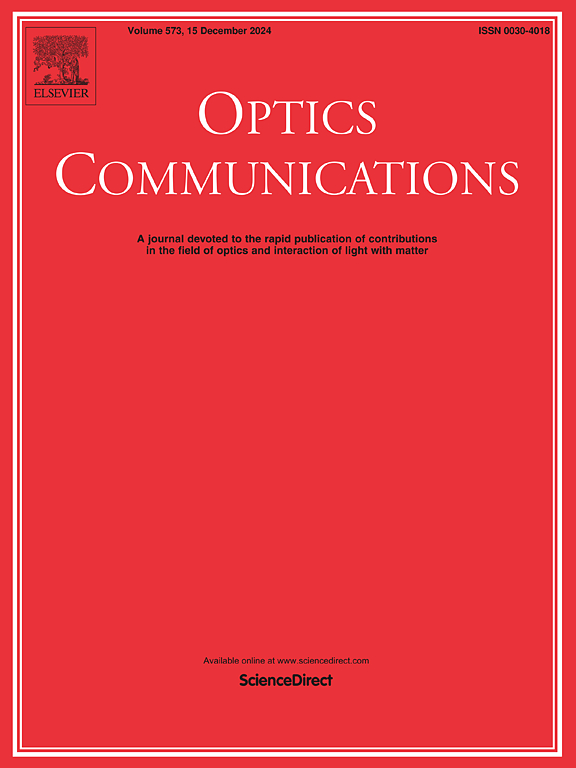Enhanced backscattering and interference of surface plasmon polaritons in ferroelectric lithium niobate/ITO heterostructures
IF 2.2
3区 物理与天体物理
Q2 OPTICS
引用次数: 0
Abstract
Long-range propagation and interference characteristics of surface plasmon polaritons (SPPs) at the interface of Fe-doped Z-cut lithium niobate (LN) coating with indium tin oxide (ITO) were demonstrated. A broken-gap band alignment is formed at the interface by depositing 150 nm-thick ITO films on the –C face of LN via magnetron sputtering, which facilitates charge transfer and generates a two-dimensional electron gas (2DEG) layer near the interface with a carrier density exceeding 6 × 1028 m−3. Density functional theory reveals that the polarization field of LN modifies the 2DEG layer within a sub-nanometer scale near the interface, endowing it with metallic-like dielectric properties. This ultrathin quasi-metallic layer significantly suppresses Ohmic losses during SPPs propagation. Simulations using an Otto attenuated total reflection configuration show that SPPs can achieve sub-centimeter-scale propagation lengths, far surpassing conventional metal-based SPP systems. Experimental validation with 532 nm laser excitation exhibited Young's double-slit-like interference fringes and diffraction patterns and a 14.6 % reduction in reflection intensity at the –C face, confirming the long-range dynamic behavior of SPPs. The LN/ITO heterostructure, synergizing spontaneous polarization and bulk photovoltaic effects, establishes a novel platform for manipulating light-matter interactions at subwavelength scales, offering significant potential for applications in nonlinear plasmonics and photonic devices.
铁电铌酸锂/ITO异质结构中表面等离子体激元的增强后向散射和干涉
研究了表面等离子激元极化子(SPPs)在掺铁z切铌酸锂(LN)涂层与氧化铟锡(ITO)界面的远程传输和干涉特性。通过磁控溅射在LN的-C表面沉积150 nm厚的ITO薄膜,在界面处形成断隙带对准,有利于电荷转移,在界面附近形成载流子密度超过6 × 1028 m−3的二维电子气(2DEG)层。密度泛函理论表明,LN的极化场在亚纳米尺度上改变了界面附近的2DEG层,使其具有类似金属的介电性质。这种超薄的准金属层显著地抑制了SPPs传播过程中的欧姆损耗。使用Otto衰减全反射配置的模拟表明,SPP可以实现亚厘米级的传播长度,远远超过传统的金属基SPP系统。在532 nm激光激发下,实验验证了SPPs的杨氏双缝干涉条纹和衍射图案,c面反射强度降低了14.6%,证实了SPPs的远程动态行为。LN/ITO异质结构,协同自发极化和体光伏效应,建立了一个在亚波长尺度上操纵光-物质相互作用的新平台,为非线性等离子体和光子器件的应用提供了巨大的潜力。
本文章由计算机程序翻译,如有差异,请以英文原文为准。
求助全文
约1分钟内获得全文
求助全文
来源期刊

Optics Communications
物理-光学
CiteScore
5.10
自引率
8.30%
发文量
681
审稿时长
38 days
期刊介绍:
Optics Communications invites original and timely contributions containing new results in various fields of optics and photonics. The journal considers theoretical and experimental research in areas ranging from the fundamental properties of light to technological applications. Topics covered include classical and quantum optics, optical physics and light-matter interactions, lasers, imaging, guided-wave optics and optical information processing. Manuscripts should offer clear evidence of novelty and significance. Papers concentrating on mathematical and computational issues, with limited connection to optics, are not suitable for publication in the Journal. Similarly, small technical advances, or papers concerned only with engineering applications or issues of materials science fall outside the journal scope.
 求助内容:
求助内容: 应助结果提醒方式:
应助结果提醒方式:


